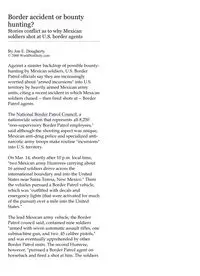Table Of ContentBorder accident or bounty
hunting?
Stories conflict as to why Mexican
soldiers shot at U.S. border agents
By Jon E. Dougherty
© 2000 WorldNetDaily.com
Against a sinister backdrop of possible bounty-
hunting by Mexican soldiers, U.S. Border
Patrol officials say they are increasingly
worried about "armed incursions" into U.S.
territory by heavily armed Mexican army
units, citing a recent incident in which Mexican
soldiers chased -- then fired shots at -- Border
Patrol agents.
The National Border Patrol Council, a
nationwide union that represents all 8,250
"non-supervisory Border Patrol employees,"
said although the shooting aspect was unique,
Mexican anti-drug police and specialized anti-
narcotic army troops make routine "incursions"
into U.S. territory.
On Mar. 14, shortly after 10 p.m. local time,
"two Mexican army Humvees carrying about
16 armed soldiers drove across the
international boundary and into the United
States near Santa Teresa, New Mexico." There
the vehicles pursued a Border Patrol vehicle,
which was "outfitted with decals and
emergency lights (that were activated for much
of the pursuit) over a mile into the United
States."
The lead Mexican army vehicle, the Border
Patrol council said, contained nine soldiers
"armed with seven automatic assault rifles, one
submachine gun, and two .45 caliber pistols,"
and was eventually apprehended by other
Border Patrol units. The second Humvee,
however, "pursued a Border Patrol agent on
horseback and fired a shot at him. The soldiers
then disembarked their vehicle, fired upon one
more Border Patrol agent and chased another
agent before fleeing [back] to Mexico in their
vehicle."
Union officials said the
members of the lead
Mexican army vehicle
were debriefed and
eventually allowed to
return to Mexico with
their arms and vehicle.
Though the incident "is the most serious to
date," the council said, "it is but one of
hundreds of incursions that have been
reported over the past several years," and it has
led union officials to call on Congress and the
Clinton administration to deal with it.
"We will pursue all avenues to bring out the
truth," said Martin L. Wilson, president of the
Border Patrol union's Local 1929, which
includes the Santa Teresa district. "We will not
let this incident go away without looking for
answers and changes for the betterment of the
members of our local."
Martin said the agents involved had "promised
to give us a first-hand account of the incident,"
and he emphasized that "this local has not
called for the ouster of the (Border Patrol) chief
(Gus de la Vina), regardless of what has been
put out by outside groups."
Mariela Melero, regional spokesperson for the
Immigration and Naturalization Service, based
in Dallas, told WorldNetDaily high-level
contacts with the Mexican government
regarding the incident are in the works, but
had no specifics. The Border Patrol is part of
the INS, and both agencies fall under the
jurisdiction of the Justice Department.
The El Paso, Texas Border Patrol office told
WorldNetDaily, "in both instances, Mexican
U.S. Border Patrol agent
soldiers apparently were not aware they had
crossed into U.S. territory." The El Paso office
acknowledged that two shots had been fired by
the Mexican soldiers, but said that after
"Border Patrol agents identified themselves
and explained" that the Mexicans were on U.S.
soil, one of the Humvees carrying the soldiers
"retreated" south while the occupants of the
second vehicle "surrendered to the Border
Patrol agents."
INS officials said that shortly after the incident,
the Mexican colonel in charge of the two
squads met with Luis Barker, chief Border
Patrol agent in charge in El Paso.
"The Mexican colonel explained that the
Mexican vehicles and officers were part of a
counter-narcotics unit that had previously been
working primarily in the interior of Mexico
and were unfamiliar with border areas," INS
said.
Paul M. Berg, chief of the Border Patrol Agent's
Association, said that U.S. border officers had
been caught armed in Mexico before as well,
and so far U.S. officials have been able to
negotiate their release "with their weapons
over the outcry of the Mexican people, who
wanted the agents prosecuted.
"The return of the (Mexican) soldiers will
continue to build the relationships necessary to
be able to accomplish this in the future," he
said. Berg added that an "official protest has
been lodged by the (U.S.) Ambassador to
Mexico with the Mexican government and they
will investigate."
Earlier, however, the Border Patrol agents'
union alleged a far more sinister explanation
for the shooting -- that the Mexican soldiers
who shot at U.S. agents may have been
attempting to collect a drug trafficker's bounty
by killing U.S. law enforcement personnel.
"That was no accident," Joseph Dassaro, vice
president of the National Border Patrol
Council, told reporters in El Paso, Texas. "The
Mexican military was well into U.S. territory
for way over a mile and chased and fired at
agents."
As confirmed by Border Patrol officials, the
Juarez cartel, one of Mexico's biggest drug
gangs, has indeed placed a bounty of $200,000
on U.S. lawmen.

